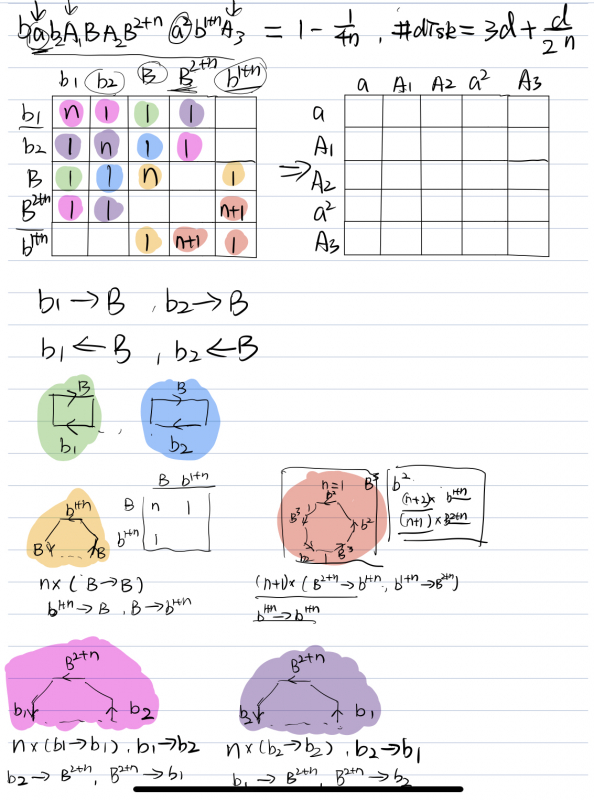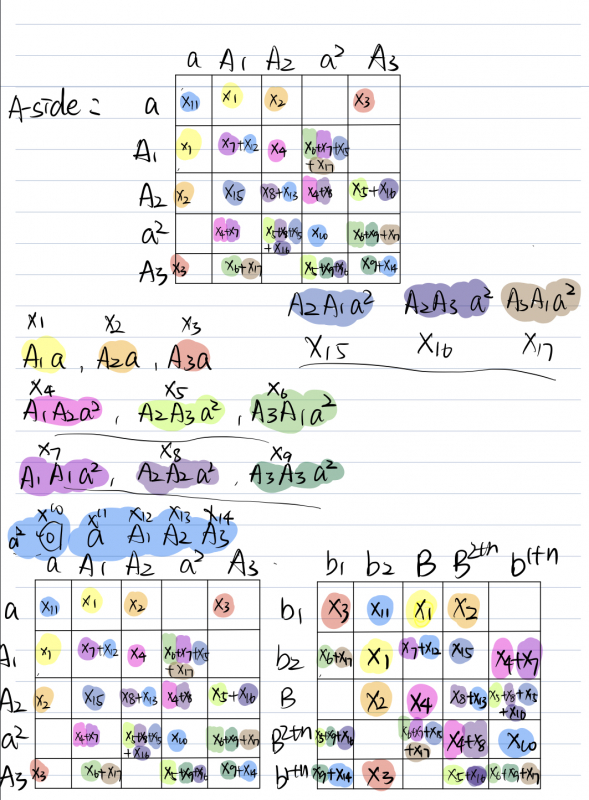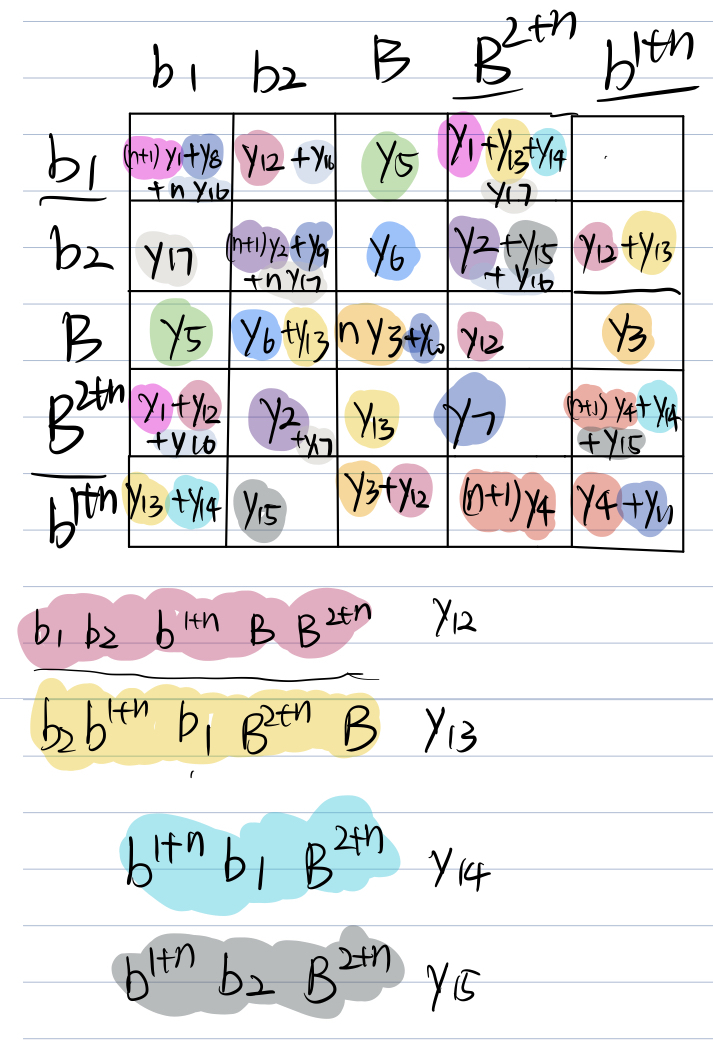Calegari's rationality theorem shows that scl only takes rational values in free groups. However, it is not known which rational numbers appear as scl values. The set of such numbers is called the scl spectrum for the free group. The algorithm in the theorem was implemented in the scallop program (later improved by Alden Walker), which allowed computer experiments to explore scl in free groups. The following histogram indicates part of the scl spectrum in the free group of rank two based on computer experiments.
In particular, one can ask scallop to calculate scl of many (thousands of) random words in free groups. The following is a histogram, where the x-coordinate of each vertical spike is a value in the spectrum, and the length of the spike represents the frequency in the random experiment.
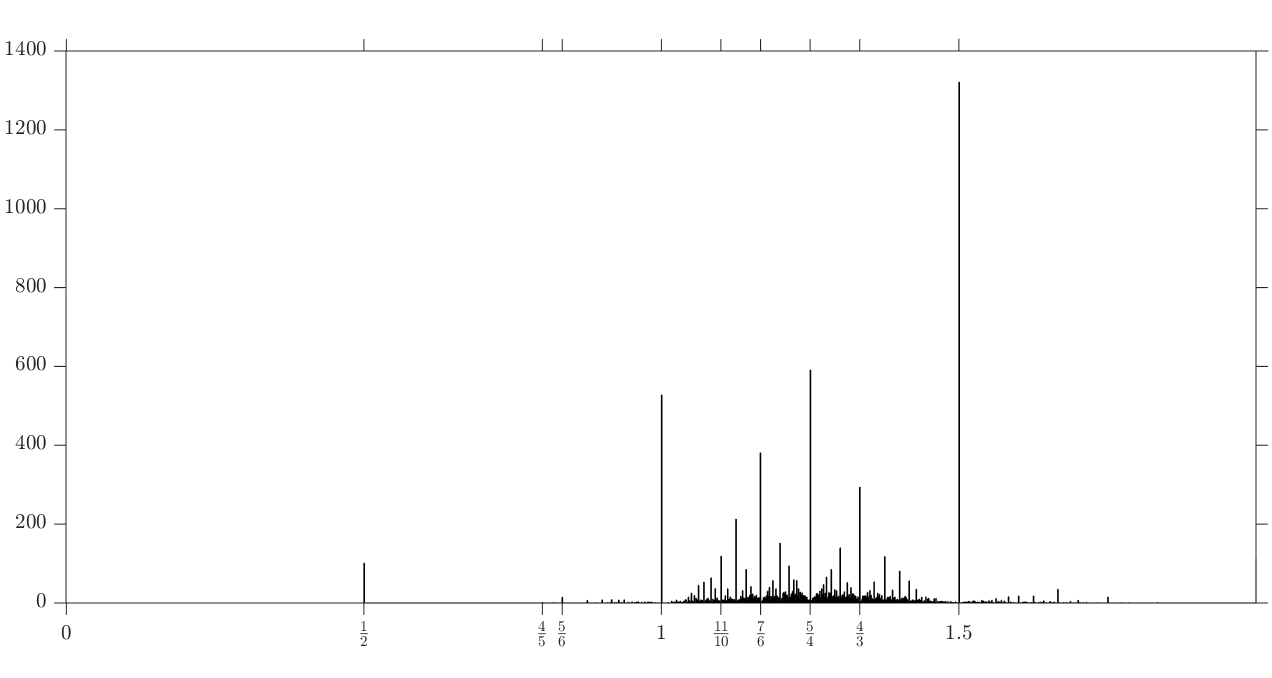
One can observe:
- No value is obtained between 0 and 1/2 (called the spectral gap);
- No value is obtained in the interval \((\frac{1}{2},\frac{1}{2}+\epsilon)\) for some \(\epsilon>0\);
- The spectrum becomes very dense after the value 1.
However, very little has been proved. Only the gap between 0 and 1/2 is known by a theorem of Duncan-Howie, which has various generalizations. Experimentally, the first accumulation point in the spectrum is 3/4 and there is a sequence of small gaps between 1/2 and 3/4, starting with a gap between 1/2 and 7/12.
A theorem of Calegari-Walker shows that the rational numbers in the spectrum can have arbitrary denominator (i.e. the spectrum surjects \(\mathbb{Q}/\mathbb{Z}\)), they made the following
Conjecture(Calegari-Walker): The scl spectrum in a free group (of rank at least two) is dense in some interval.
Our goal is to experimentally explore scl in families of words, specifically in free groups, to better understand the conjecture above as well as the open questions below. In addition, we would like to prove some explicit formulas for scl on families of words. This is related to finding the extremal surfaces (i.e. achieving the infimum in the topological definition) corresponding to such families.
Open Questions:
- What are the values in the spectrum between 1/2 and 3/4? Do they fit into a simple formula?
- Is there a description of words with scl=1/2?
- What are some sequences of small values in the spectrum? Where do they accumulate to?
In particular, we would like to explore scl on two-parameter families of words, since they are less understood as one-prameter ones.
Previously Known Results
- We have \(scl_G(g) \ge \frac{1}{2} \text{ for all } g \in G\), where \(G\)is a free group.
- In \(F_2 = \langle a, b\rangle \text{, for all }m, n \ge 2\), Jiangcheng Tang discovered an experimental formula
\(scl_G(a^{n-1}ba^mBA^nbA^{m-1}B) = 1 - \frac{1}{2m} - \frac{1}{2n}\)
There is a proof but not written down in the literature.
- Let \(n = 2\). Then,
\(scl_G(aba^mBA^2bA^{m-1}B) = \frac{3}{4}-\frac{1}{2m}\)
and
\(\lim\limits_{m \to \infty} \mathrm{scl}_G(aba^mBA^2bA^{m-1}B) = \frac{3}{4}\)
So \(\frac{3}{4}\) is an accumulation point of the image of scl, conjectured to be the smallest accumulation point.
- Nicolaus Heuer experimentally found the following formulas:
1) For N > 0, we have:
\(A^N Babaa^N BAbABAAbaBab = \frac{3*N^2 + 3*N + 1}{4*(N^2)+6*N+2}\)
2) For the family \(BaBAbb b^N aBA B^N abA\), we have that
\(BaBAbb b^N aBA B^N abA =\frac{3N-1}{4N}\) for N even
\(BaBAbb b^N aBA B^N abA = \frac{3N + 1}{4N + 2}\) for N odd
We are interested in the following questions in this project.
Questions
- Is scl dense in some interval? E.g, is every rational number in some interval obtained by scl for some word in the free group?
- What other formulas for families of words can we find?
- What surfaces can we find that represent a family of words?
Part 1: Gathering Data
We used the scallop program to compute scl. We wrote scripts to test scl for families of words. In particular, we gathered results for the following families of words:
\(aBA^nba^{n+2}B^{m+2}AbABAb^{m+2}\)
\(b^nA^mB^nAbA^2Ba^{m+3}\)
\(b^{2m+1}abAB^{2m+1}AB^{n+2}a^2b^{n+1}A\)
Word Family #1
For the family \(aBA^nba^{n+2}B^{m+2}AbABAb^{m+2}\), here are the values of scl we collected:

In particular, the formula
\(\frac{15mn+27m-3n-1}{12mn+24m-2n}\)
works experimentally for the following (shaded) values of m and n:

Word Family #2
For the family \(b^nA^mB^nAbA^2Ba^{m+3}\), we gathered the following data:
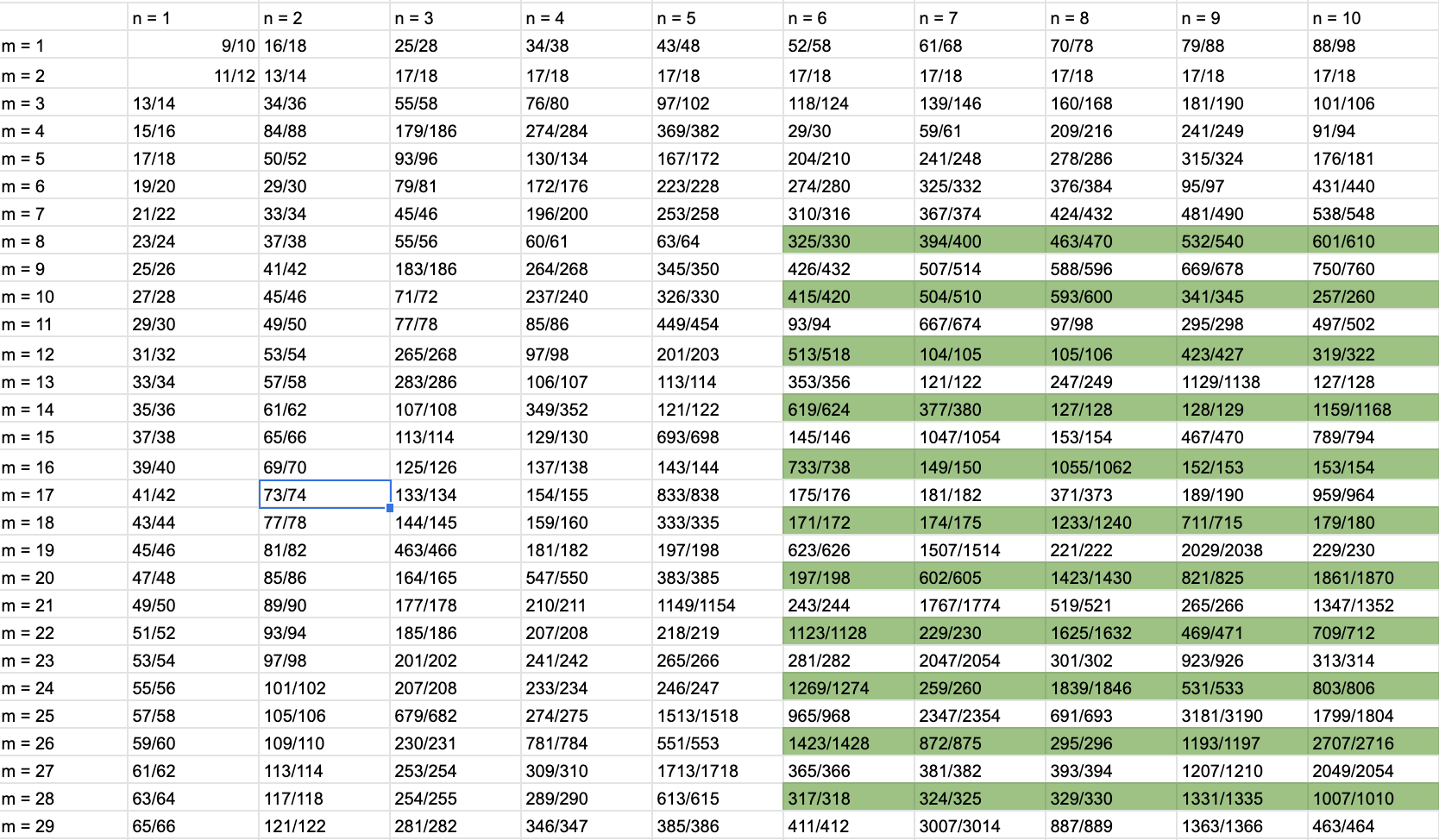
In particular, the formula \(1 - \frac{4n - 4}{(m+2)(mn - 2m + 20n - 20)}\) works for \(n \ge 6, m \ge 8, m \text{ is even.}\)
Word Family #3
For the family \(b^{2m + 1}abAB^{2m+1}AB^{n+2}a^2b^{n+1}A\), we gathered the following data:
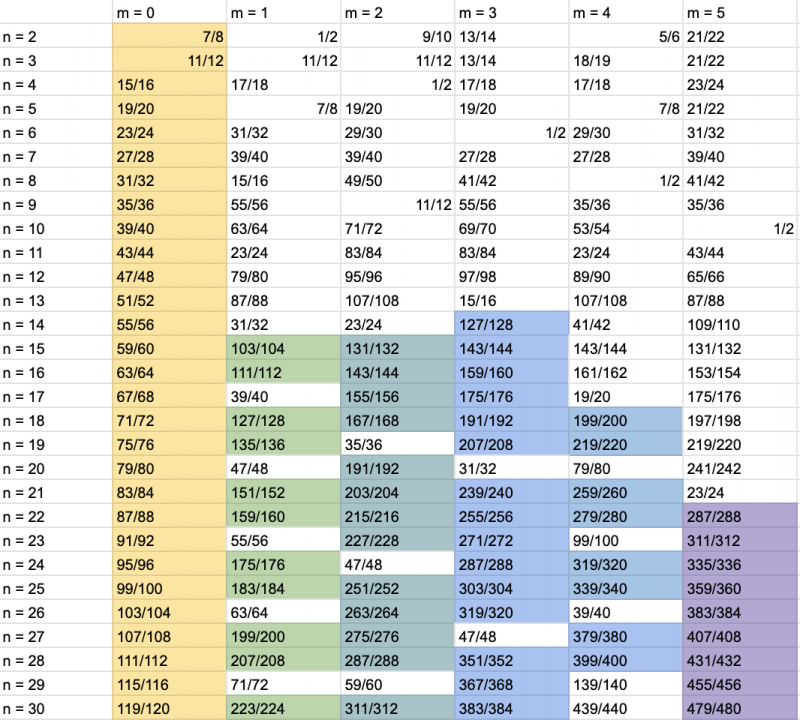
When we let \(m = 0\), the word family becomes \(babABAB^{n+2}a^2b^{n+1}A\), which satisfies the relatively simple formula
\(scl_G(babABAB^{n+2}a^2b^{n+1}A) = 1 - \frac{1}{4n}\)
In particular, the value of scl on this word family approaches 1 as \(n\) approaches infinity.
We chose to further analyze this family of words topologically.
Part 2: Finding a Surface
We first identify the following constraint: for each "turn" in A, there is a corresponding "turn" in B, based on the word in question. For example, consider the word \(babABAB^{n+2}a^2b^{n+1}A\). Then if we have a turn from \(a^2 \text{ to } a^2\), then we must also have a corresponding turn from \(B^{n+2} \text{ to } b^{n+1}\).
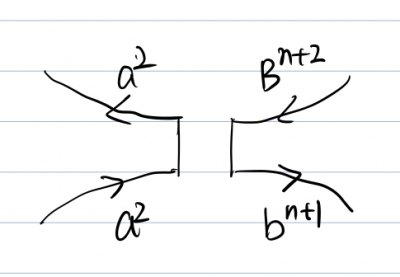
We attempt to create pieces on the a and b side, which can either be disks or annuli. Through some methods (guess and check, linear programming), we attempt to minimize the number of disks corresponding to the infimum in the definition of scl. These pieces must follow the given constraints:
- The number of turns from each \(a_i, b_i\) must be the same. This is intuitive since scl is calculated from whole number powers of a given word.
- Similarly, the number of turns to each \(a_i, b_i\) must be the same.
- The \(a\) and \(b\) sides must correspond (as mentioned on the previous slide).
- The number of disks needs to satisfy the equation
\(scl_G(g) = \inf -\frac{\chi (S)}{2n(S)}\)
